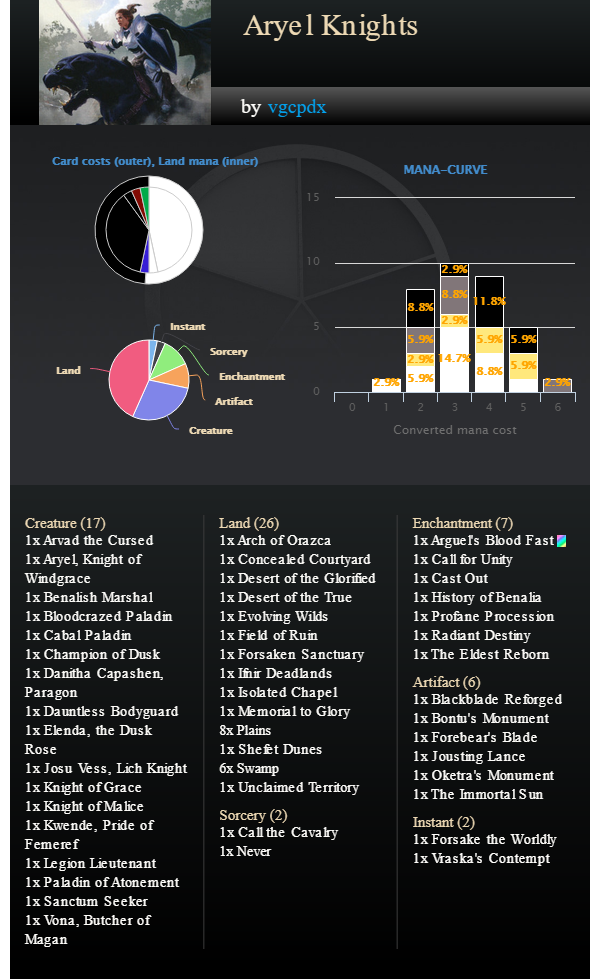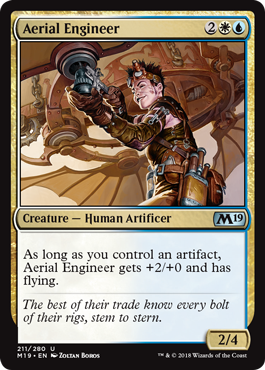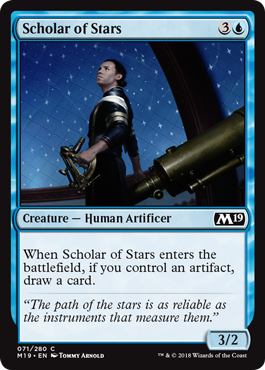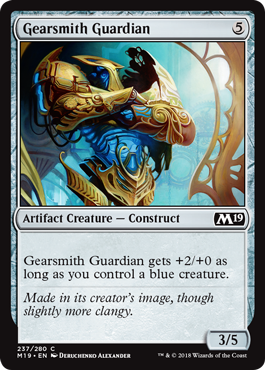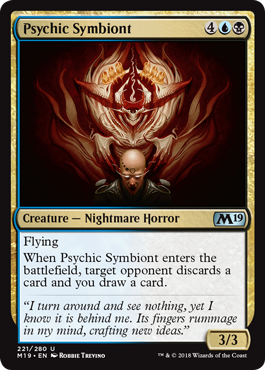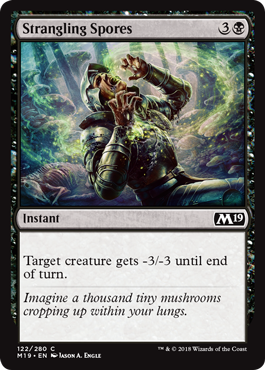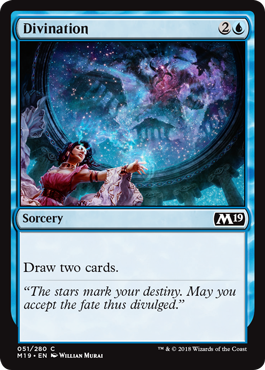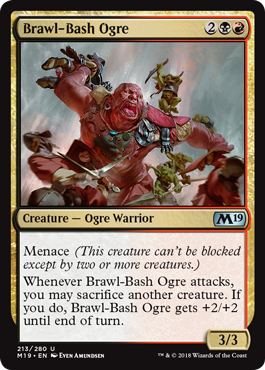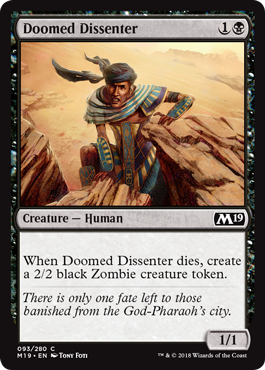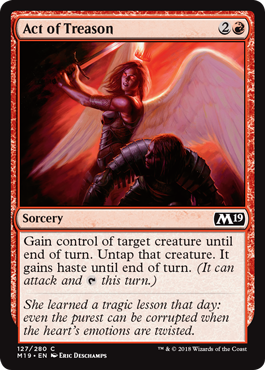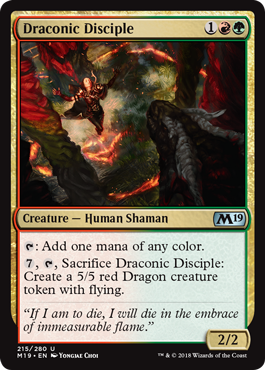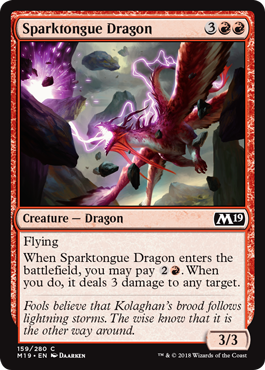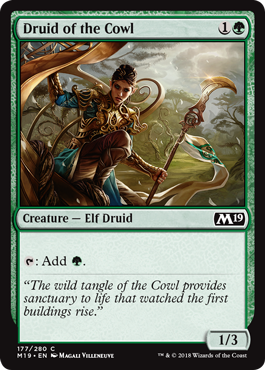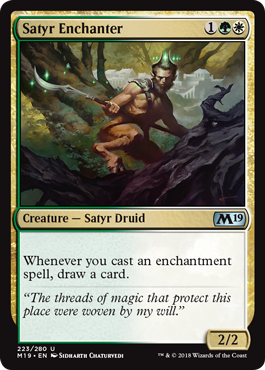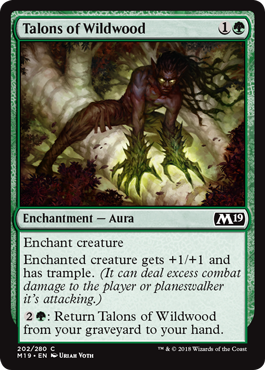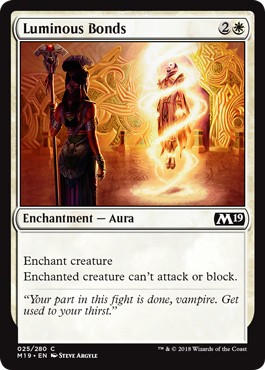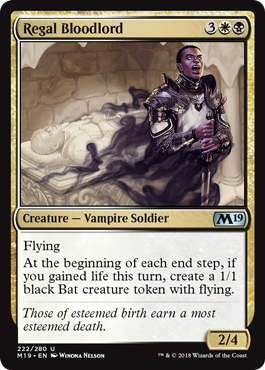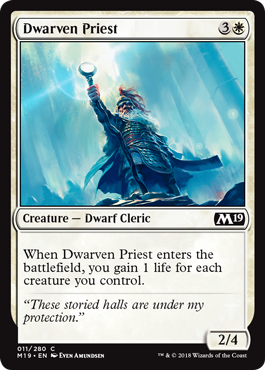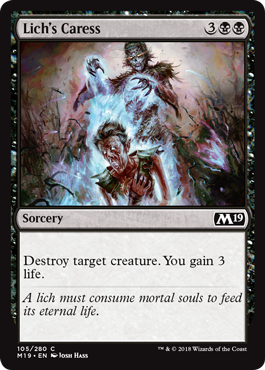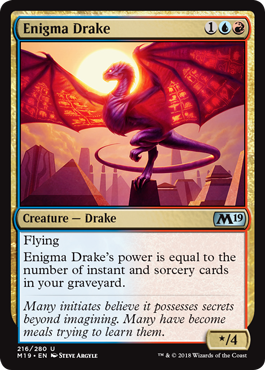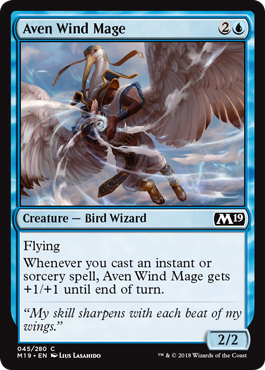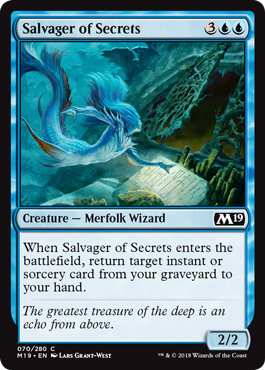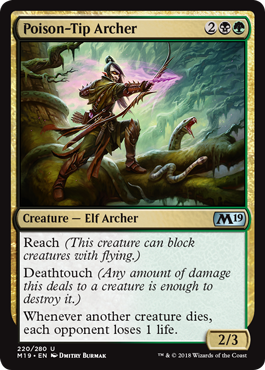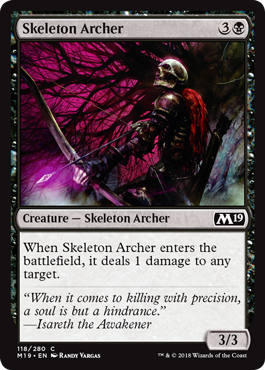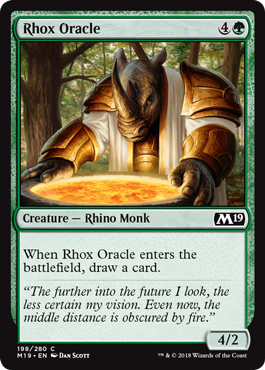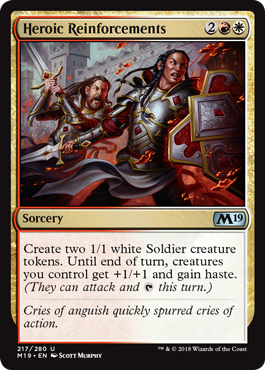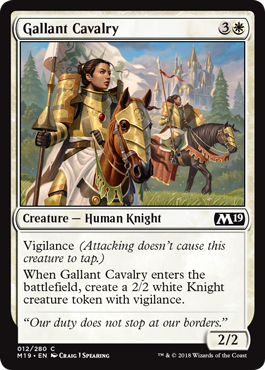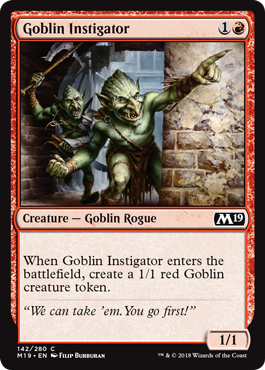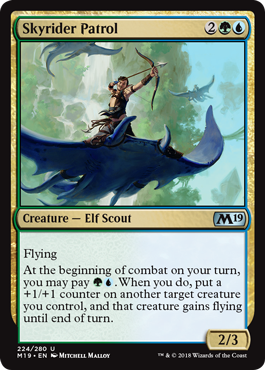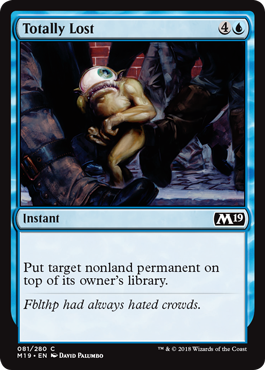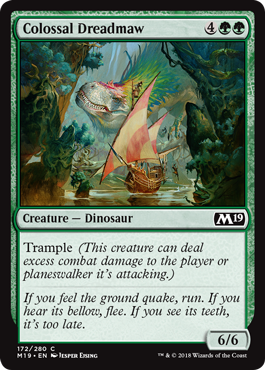Grand Prix Sacramento confirmed what I suspected—M19 is a cheesy format. There are multiple cards that read “win the game” with minimal setup. This leads to some very strange tensions in the format as you may find yourself grinding a midrange matchup only to have the game come to a halt when someone slams a Banefire or a Prodigious Growth to just lock up the game. I have never experienced a tournament where so many of my opponents who defeated me would apologize for their win because of the cheesy nature of their finish. I started doing it too. If we’re all cutting stinky cheese in this format we might as well be polite about it.
I got to play three cheesy decks in Sacramento on my way to an 11-4 finish. Let’s look at them.
Day 1 Sealed with Green-White 4 Legged Animals (6-2)
| Creatures: |
1x Druid of the Cowl
1x Diamond Mare
1x Shield Mare
1x Pegasus Courser
1x Centaur Courser
1x Skyscanner
3x Star-Crowned Stag
1x Vine Mare
1x Bristling Boar
1x Gallant Cavalry
1x Angel of the Dawn
1x Colassal Dreadmaw
1x Ghastbark Twins
1x Hungering Hydra
Artifacts:
1x Sigiled Sword of Valeron
1x Arcane Encyclopedia
Sorceries:
2x Rabid Bite
Enchantments:
1x Talons of Wildwood
1x Prodigious Growth
Lands:
9x Forest
9x Plains
Sideboarded Cards:
1x Rhox Oracle (large threats)
1x Giant Spider (skies)
1x Invoke the Divine (ench/artifacts)
Heading into this sealed format I knew a couple of things I wanted to do. First is to avoid 2-drops that either have 1 toughness or get blanked by 1/3s. There are so many great 1/3 value creatures in this format (I’m playing two of them) that your average Grizzly Bear variant will simply become irrelevant as the game goes on. Here with Druid of the Cowl and Diamond Mare I have a pair of creatures that are able to get me to my long game by either ramping me or helping me stay alive. Highland Game and Greenwood Sentinels were never considered.
Avoiding 2-drops creates an interesting problem, though, as I am still in a beat-down deck with triple Stag. I absolutely needed to hit those Stags so I opted into an 18 land manabase to ensure I hit my 4-drops. I also included the Arcane Encyclopedia in case I flooded out and the Talons of Wildwood along with the Sigiled Sword, a cheese card in it’s own right, also gave me ample mana sinks in case I drew too many of those 18 lands. I have also noticed how punished people have been getting for missing their third or even fourth land drop. For now I believe 18 lands is correct.
With so many haymakers in my deck it becomes a tough decision about whether to play or draw. The advantages of drawing first are that you are more likely to hit your land drops and draw additional gas, two things I wanted to do. Ultimately, though, I felt like I would be the aggressor with triple Stag and the 18th land was there to help me hit my drops. I opted to play at every instance. I am unsure if this is correct.
The Cheese: Vine Mare + auras is a well-hated win condition and for good reason. There are no edict effects and the prevalence of such a strategy has led to naturalize effects being maindeckable. Prodigious Growth is also just such a house without the horse as it can turn anything into a lethal threat out of nowhere. Don’t overdo the auras, three is probably the max and I only really like Talons and Oakenform. Swords and Axes can be even better.
Cheese Ranking: Roquefort, a stinky powerful blue that some people absolutely adore but most people wish didn’t exist.
Day 2 Draft 1 with Blue-Red Power Nap (2-1)
| Creatures: |
1x Departed Deckhand (P1P1)
1x Dark-Dweller Oracle
2x Surge Mare
1x Boggart Brute
2x Aven Wind Mage
1x Mirror Image
1x Enigma Drake
1x Salvager of Secrets
1x Gearsmith Guardian
2x Sparktongue Dragon
Sorceries:
1x Divination
1x Sleep
Instants:
1x Spark
1x Lightning Strike
1x Essence Scatter
3x Disperse
1x Cancel
1x Electrify
Lands:
10x Island
7x Mountain
Sideboarded Cards:
1x Gearsmith Guarding (mistake to leave out)
Opening an unplayable rare (I hate you, Detection Tower) I took Departed Deckhand as it can be a lot of damage for such a low cost. Pack 1 gave me a lot of blue cards to start the pack so I hedged on powerful off color cards towards the end, grabbing Rise from the Grave, Aerial Engineer, and Enigma Drake to set up powerful cards in whatever my second color might be. Opening another unplayable rare in pack 2 (I still hate you, Detection Tower) I snapped a Lightning Strike and committed to UR.
Leaving the second Gearsmith Guardian out of the list was an absolute mistake. During a Sleep turn having the extra power made a huge difference and games usually went long enough to play multiple 5s. Dark-Dweller Oracle was too often a bear so sometimes I made that swap. Against White decks I instead swapped it with Mirror Image as Oracle is great against Luminous Bonds.
The Cheese: Sleep is such a powerful tempo card as all that it asks of you is to have enough power to 2-shot your opponent. With triple disperse and a pair of counterspells I could reliably answer any blockers that caused problems on the second turn. Additional reach in Shock, Lightning Strike, and the pair of Sparktongue Dragons helped close so many games.
Cheese Ranking: Asiago Pressato, mild, firm, creamy, easy to eat quickly and then go take a nap from a full belly.
Day 2 Draft 2 with Black-White Holy Lifegain, Batman! (2-1)
| Creatures: |
1x Rustwing Falcon
2x Vampire Neonate
1x Child of Night
1x Daybreak Chaplain
2x Reassembling Skeleton
1x Mentor of the Meek
1x Skyscanner
1x Hired Blade
1x Dwarven Priest
1x Epicure of Blood
1x Regal Bloodlord (P1P1)
1x Psychic Symbiont
1x Chromium, the Mutable
Artifacts:
2x Marauder’s Axe
Sorceries:
1x Mind Rot
1x Rise from the Grave
2x Lich’s Caress
Enchantment:
1x Luminous Bonds
Instant:
1x Abnormal Endurance
Lands:
1x Rupture Spire
8x Swamp
6x Plains
2x Island
Sideboarded Cards:
1x Novice Knight
1x Walking Corpse (pull splash vs. RW)
I am typically not a fan of taking a gold card first but Regal Bloodlord was heads and shoulders above any of the other cards in the packs. However, through most of packs 1 and 2 I was unclear what my second color would be. Black flowed to me as I followed up Bloodlord with a Lich’s Caress and Rise from the Grave but then I found myself taking very defensive creatures, such as Reassembling Skeleton. I hedged into White with a Luminous Bonds and Green with a Vivian’s Invocation but mostly just took Black cards until I could see a plan. A few Neonates and Mentor solidified me with my first plan of lifegain but I also felt I had too few win conditions so I took the Blue fliers to help me finish out games. The Axes as well helped turn my otherwise unimpressive creatures into real threats. Multiple games were won with Bats holding Axes.
I was playing a long game so the Blue splash made a bit of sense, especially given the low power level of my draft. Psychic Symbiont performed better than Chromium but when I played a WR deck in round 15 I just pulled all of the clunky slowness and jammed cheap blockers. This proved correct as I was able to win both the sideboarded games.
The Cheese: The lifegain synergies of Vampire Neonate, Epicure of Blood, and Regal Bloodlord created unwinnable boardstates for my opponents. I was even able to mill out an opponent just by having an impenetrable board and a few more cards in my library. It was slow and my opponents played it out but most of my wins were locked up five to ten turns before lethal was given.
Cheese Ranking: Pont L’eveque, stinky washed rind double cream that tastes delightful (buttery and mushroomy) but stinky to anyone across the table from you.
Takeaways
- 2-drops need to do something
- But bring in bears against RW
- Splash thoughtfully, don’t go crazy
- Removal is bad, don’t prioritize it over your gameplan
- Synergy matters, even if it’s just cheesy
I hope you enjoyed my cheese platter! Go get yours! Leave comments about the format or cheeses you like.
Be well!




























